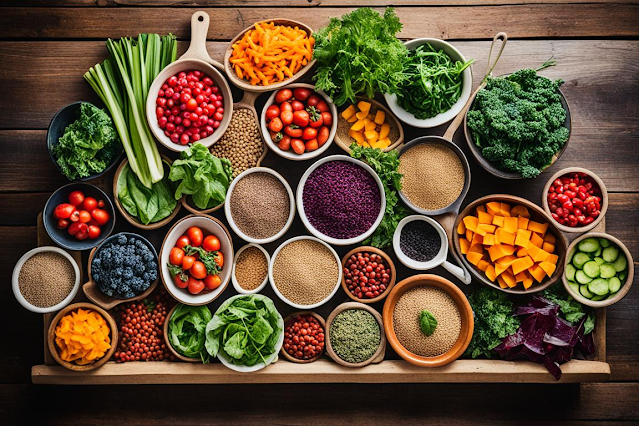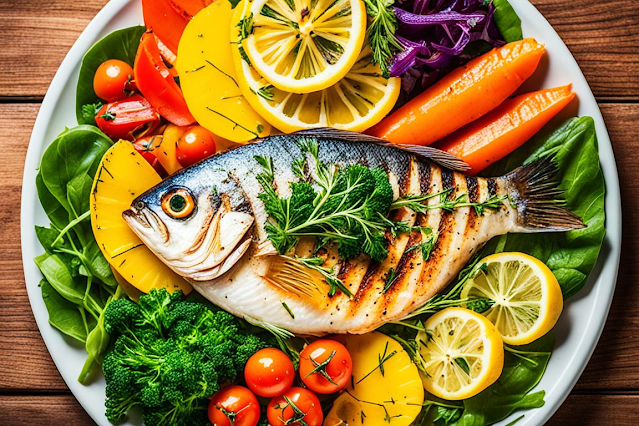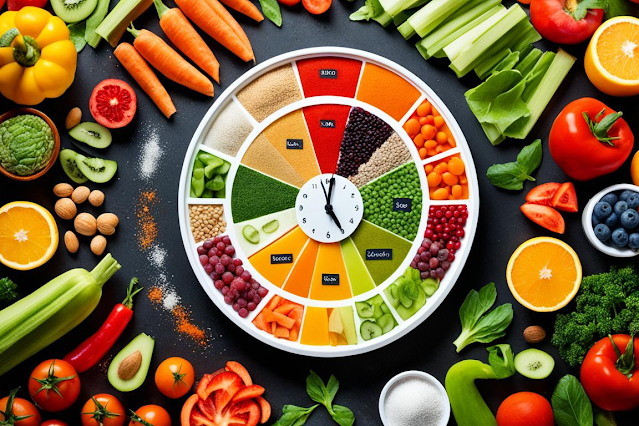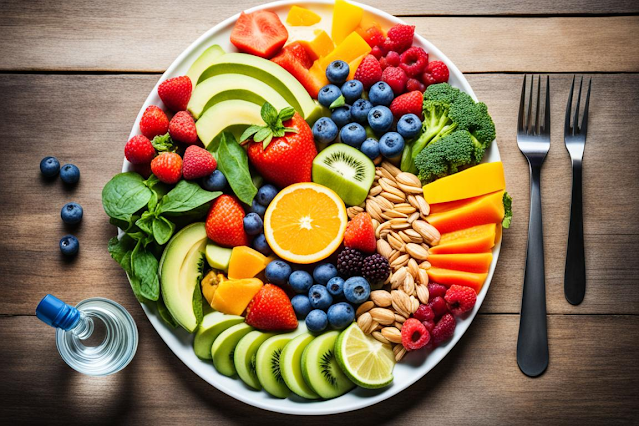Explore Fresh Healthy Food Choices & Tips
Welcome to our guide on fresh, healthy food choices. We're here to show you the path to a diet that's good for you. This is important in a world where fast and processed foods are everywhere. But, making healthy choices isn't always easy. So, we'll help you find the way.
Key Takeaways:
- Understanding the significance of organic meals and clean eating.
- Exploring various fresh and healthy food choices.
- Gaining practical tips for incorporating healthy food choices into your daily routine.
- Learning how to create a nutritious diet that supports overall health and well-being.
- Unveiling the secrets of maintaining a healthy lifestyle through food choices.
Understanding the Fundamentals of Healthy Eating
To be healthy, starting with good eating habits is key. We will talk about the basics of eating well. You'll learn great tips for choosing what food to eat.
The Balance of Calories and Activity
Being the right weight is about what you eat and how much you move. It's pretty simple. You eat just enough to keep your body going. Remember, it's all about good food, not denying yourself.
A Diverse Diet for Adequate Nutrients
Eat different things to get all the nutrients you need. That means lots of fruits, veggies, and more. Adding variety to your meals makes eating fun and good for you.
Recommended Daily Caloric Intake
Knowing how many calories you need is important to keep fit. The amount you should eat changes with your age and daily activities. Experts like dietitians can give you the right numbers and help plan your meals.
Meal planning is a great idea for eating well every day. It helps you be ready for each meal. Focus on nutrition for meals that are good for you and taste great. Use fresh ingredients and easy recipes to get all the good stuff your body needs.
We will also talk about carbs soon. Picking foods with fiber and focusing on plants makes your diet even better.
Essential Carbohydrates: Choosing Fiber-Rich Options
Choosing the right carbs is key for a healthy diet and well-being. This means favoring plant-based and whole food options. They come with many benefits for our health.
Fiber is great for digestion and overall health. It helps manage blood sugar, reduce cholesterol, and controls weight. It makes you feel full longer, which stops you from overeating.
"Fiber not only aids in digestion but also helps to regulate blood sugar levels, lower cholesterol, and support weight management."
There are many tasty and healthy options in plant-based meals. You can add fruits, veggies, legumes, and whole grains to get important nutrients. This boosts your health in many ways.
Eating a diet high in fiber is good for you. It ensures your body gets the energy it needs. So, when planning your meals, go for those rich in fiber from plants.
Incorporating Fruits and Vegetables into Every Meal
Want to boost your health? Add fruits and veggies to each meal. They're loaded with vitamins and minerals. Plus, they boost your immune system.
Choosing organic is even better. Organic produce is grown without harmful chemicals. It's richer in nutrients than regular produce, making it a healthier choice.
Below are some recipes to help you eat more fruits and vegetables:
- Breakfast: Kick start with a fruit-filled smoothie bowl. Top it with berries, bananas, and kiwi.
- Lunch: Make a vibrant salad with greens, tomatoes, cucumbers, and avocado. Add a homemade vinaigrette.
- Dinner: Try a veggie stir-fry with broccoli, peppers, carrots, and snow peas. Serve over rice or quinoa for extra nutrition.
- Snacks: Cut up some carrots, celery, and peppers. Pair them with hummus for a tasty snack.
Vary your choices of fruits and vegetables to keep meals exciting. Including organic items makes your food even better for you. It ensures you feed your body top-grade food.
"Choosing organic produce allows you to enjoy the full benefits of fruits and vegetables without exposing yourself to harmful chemicals."
Make each dish beautiful and delicious with fruits and veggies. This way, you're on track to a healthier, more balanced diet.
Healthy Protein Sources: The Benefits of Fish
Fish is rich in protein and offers many health perks. Adding fish to your meals can help you eat a variety of nutrients. This is true whether you go for fatty fish or leaner choices.
Integrating Oily and Non-Oily Fish
Eating both kinds of fish helps you get various nutrients. Oily fish like salmon and sardines are packed with omega-3s. These help your heart and brain while reducing swelling. Non-oily fish, such as cod, are lean but still full of protein and nutrients.
Having a mix of fish types in your meals boosts their health benefits. Try pairing grilled salmon with steamed cod and vegetables. It's a tasty, healthy choice.
Weekly Fish Consumption Recommendations
The American Heart Association suggests eating fish at least twice weekly. This supports your omega-3 and nutrient needs. Yet, the fish's quality and source are key.
Choose fish that's responsibly caught and safe to eat. Look for the MSC (Marine Stewardship Council) or ASC (Aquaculture Stewardship Council) marks for this assurance. These labels mean the fish is caught or farmed in a mindful way.
Certain fish might not be safe for pregnant or nursing women, or young kids due to mercury. Always check with your doctor before adding fish to their diet.
| Benefits of Fish Consumption |
|---|
| Fish is an excellent source of high-quality protein. |
| Oily fish provides essential omega-3 fatty acids for heart and brain health. |
| Non-oily fish offers a leaner protein source with essential nutrients. |
| Regular fish consumption is associated with a reduced risk of heart disease. |
| Fish is rich in vitamins and minerals, including vitamin D, selenium, and iodine. |
Fish is great for you, but it's just one part of eating well. Add in whole grains, veggies, and legumes for a complete, tasty meal. This way, you'll support your health and happiness.
Reducing Saturated Fat and Sugar for a Healthier Heart
Eating less saturated fat and sugar is key for a healthy heart. A diet high in these can cause heart problems. It's important to eat well and pick foods that help your heart.
Try to eat lean proteins like chicken or fish. They have less fat than red meat. Adding plant-based proteins like tofu helps your heart too.
Be careful with sugars in processed foods. Look for names like high fructose corn syrup. Try to enjoy natural sweets like fruit instead of sugary snacks.
Changing your diet can cut down on bad fats and sugars. This is good for your heart and well-being.
Meal planning makes it easy to eat for your heart. Use lots of fruits, veggies, and whole grains. Mix in some lean proteins for a perfect balance.
Check out this table for some heart-healthy meal ideas:
| Ingredient | Meal Idea |
|---|---|
| Salmon | Grilled salmon with roasted vegetables |
| Oats | Overnight oats topped with berries and nuts |
| Spinach | Spinach salad with grilled chicken and avocado |
| Quinoa | Quinoa-stuffed bell peppers |
| Legumes | Chickpea curry with brown rice |
A balanced diet helps your heart and your health in general. Focus on good foods and you'll feel better. It's all about making smart choices for your heart.
Managing Salt Intake to Prevent Health Risks
Eating the right amount of salt is critical for staying healthy. Too much salt can cause high blood pressure. This raises your risk for heart and brain issues.
The Impact of Salt on Blood Pressure
Too little salt isn't the problem; it's too much. High amounts can spike your blood pressure. This makes you more likely to get heart problems.
Less salt means lower blood pressure. This is good for your heart and reduces heart disease and stroke risks.
Identifying High-Salt Foods
Knowing what foods are high in salt is key. Many packaged foods have a lot of salt, even if they don't taste salty. Learning about these foods helps you choose better.
Here are some foods with a lot of salt:
- Canned soups and broths
- Packaged snacks
- Processed meats (e.g., deli meats, bacon, sausage)
- Canned vegetables and beans
- Condiments and sauces (e.g., ketchup, soy sauce)
Checking food labels is a good habit. It helps you lower how much salt you eat.
Tips for Meal Planning and Creating Wholesome Recipes with Reduced Salt Content
Planning meals with less salt is doable. Here's how:
- Go for fresh ingredients: Use lots of fresh fruits, veggies, lean meats, and whole grains. These are naturally low in salt.
- Season with herbs and spices: Spices make food tasty without salt. They're good for you and add a lot of flavor.
- Avoid processed foods: Packaged foods are often full of salt. Eat homemade meals more to cut back on salt.
- Try new seasonings: Lemon, vinegar, garlic, and onion are all great salt-free spices. Use them to make your food flavorful.
Planning meals ahead can help you watch your salt. Include low-salt dishes with your favorite fresh ingredients. Trying new flavors makes cutting salt fun.
Watch your salt, know what foods are high in salt, and follow these meal planning tips. You'll boost your health and enjoy eating at the same time.
Physical Activity: A Key Component of a Balanced Lifestyle
Staying healthy includes being active. Exercise is great for your body and mind. It helps keep you fit and works well with eating healthy.
Working out helps you stay at a good weight. It makes your heart and body strong. This lowers your chance of getting sick and helps you sleep better. Plus, you'll feel happier and less stressed.
Choose foods that give you energy and keep you strong. Eat carbs, proteins, and good fats with every meal. This helps your body do its best when you exercise.
It's smart to plan what you eat. Cook healthy meals ahead of time. This stops you from eating bad foods and helps you stay strong.
Do what you like to stay active. It could be walking, yoga, or team sports. Try to be active every day, aiming for 150 minutes of exercise weekly. It's also good to do muscle workouts several times a week.
Being fit is a long-term choice. Start slowly and get more intense over time. This keeps you from getting hurt and helps you improve without stress. Making exercise part of your routine helps you live better.
The Importance of Hydration for Overall Health
Hydrating is key to staying healthy and feeling good every day. It's important for our bodies to work well and can affect our health in many ways. By picking smart drinks and making sure we get enough fluids each day, we look after our nutrition and well-being.
Choosing Healthier Beverages
Selecting the right drinks matters just as much as drinking enough. Skip the sugary sodas and energy drinks. Instead, go for water, herbal teas, pure fruit juices, or water with added fresh fruits and herbs. These choices not only meet our thirst but also add to our healthy eating plans.
How Much Fluid to Drink Daily
The daily amount of water we need changes based on size, how active we are, and our climate. A good start is aiming for 8 cups (64 ounces) a day. But, what you need might be different. Always listen to your body. Pay attention to urine color; light yellow means you're hydrated well.
Adequate hydration plays a crucial role in maintaining our overall health and well-being. By choosing healthier beverages and being mindful of our fluid intake, we can effectively support our balanced nutrition and promote optimal bodily functions.
Adding drinks that hydrate and nourish to your meals is smart. Try fruit salads, smoothies, or veggie soups. These not only help with your fluid needs but also add nutrients to your diet. Including these in your meal plan will boost your health and happiness.
Do Not Overlook the Significance of Breakfast
Breakfast is key because it jumpstarts your day. It gives you the energy and nutrients you need. It's important to make time for this meal each morning.
Healthy Breakfast Choices
There are many good breakfast options. They can taste great and provide what your body needs. Here are some examples:
- Whole grain oatmeal topped with fresh berries and a sprinkle of nuts
- Greek yogurt with granola and sliced bananas
- Avocado toast on whole grain bread
- A veggie-packed omelet with whole wheat toast
- Smoothie bowl made with frozen fruits, spinach, and almond milk
These meals are not just tasty. They are filled with vitamins, minerals, and fiber too. This will help you start the day in a healthy way.
Breakfast's Role in Daily Nutrition
Having breakfast helps you keep a healthy diet all day long. It prevents you from snacking on things that are not good for you. A breakfast full of protein, carbs, and fats is the best. It keeps you full and happy till lunch.
Eating breakfast also guarantees you get the right nutrients. You get to eat different food groups. This makes for a balanced and nourishing meal.
Research shows, a good breakfast leads to better health and energy. It improves how your brain works too. So, eating a nutritious breakfast is really important.
Make starting with a healthy breakfast a habit. It helps set the tone for a day of good eating. Whether quick or leisurely, don't skip this meal. It prepares you for the hours ahead.
Conclusion
We've shared key insights into choosing healthy foods and why they're important. By choosing fresh, wholesome foods, you can improve your health and feel better.
Planning meals is vital for eating well regularly. With a variety of healthy meals, your body gets what it needs to be strong.
To live a healthier life, use our tips. Choose fresh foods, focus on nutrition, and plan your meals well. This can lead to a journey towards better health and happiness.
FAQ
How can I incorporate healthy food choices into my daily regimen?
Start by choosing organic meals and clean eating. They make your diet healthier and improve well-being.
What are some tips for maintaining a balanced diet and getting adequate nutrition?
Meal planning is key. Focus on recipes with fresh, wholesome ingredients. This way, you get plenty of nutrients and keep your diet balanced.
Why is it important to choose fiber-rich options when it comes to carbohydrates?
Fiber is great for health and digestion. Aim for plant-based and whole foods to boost your fiber intake.
How can I incorporate fruits and vegetables into every meal?
Add organic fruits and veggies to all dishes. This way, you get more vital vitamins and minerals.
What are the benefits of consuming fish as a protein source, and how often should I eat it?
Fish is a top protein source for your health. Eat it at least once or twice a week, both oily and non-oily kinds, to get the best results.
What strategies can I use to reduce saturated fat and sugar intake for a healthier heart?
Focus on balanced nutrition in your meal planning. This reduces saturated fat and sugar, which helps your heart stay healthy.
How can I manage my salt intake to prevent health risks?
To avoid problems like high blood pressure, watch out for salty foods. Make meals with less salt to reduce your risk.
How does physical activity complement a balanced diet, and how can I incorporate exercise into my daily routine?
Exercise is crucial for a balanced life. Combine it with nutritious meal plans to boost your overall health and happiness.
What role does hydration play in overall health, and how can I ensure proper hydration?
Staying hydrated is key for good health. Choose healthy drinks and try to drink enough water every day. Including water-rich meals in your plan can also help.
How important is breakfast, and what are some healthy breakfast choices to include in my meal planning?
Breakfast is very important for your health. Choose foods for your morning that are good for you. This supports a healthy start each day.
What are the key takeaways from this article on fresh healthy food choices and meal planning?
Remember, choosing fresh and healthy foods is vital. They benefit your diet and promote good meal planning for your health and happiness.
Source Links
- https://www.nhs.uk/live-well/eat-well/how-to-eat-a-balanced-diet/eight-tips-for-healthy-eating/
- http://calfresh.dss.ca.gov/healthyliving/healthy-recipes
- https://www.nutrition.gov/topics/nutrition-life-stage/children/kids-corner




